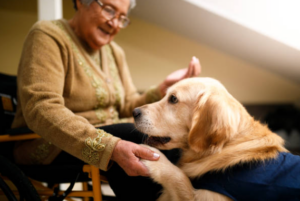Training and Placing Canine Companions in Shelters

In the often-challenging environment of animal shelters, the healing power of therapy dogs has emerged as a beacon of hope. Beyond being adorable companions, therapy dogs play a pivotal role in providing comfort, reducing stress, and creating a positive atmosphere for both staff and residents. In this comprehensive exploration, we delve into the essential aspects of training and placing therapy dogs in shelters, uncovering the transformative impact they have on the well-being of both humans and animals.
The Power of Canine Companionship in Shelters
The Shelter Struggle: Addressing Stress and Anxiety
Animal shelters, despite their noble purpose of providing temporary refuge for animals in need, often become spaces filled with stress and anxiety. This environment is not only challenging for the animals awaiting adoption but also for the dedicated staff who work tirelessly to care for them. The constant influx of new animals, unfamiliar surroundings, and the inherent uncertainty of shelter life contribute to heightened stress levels.
This is where the transformative power of canine companionship comes into play. Therapy dogs, with their innate ability to provide comfort and unconditional love, become beacons of solace in the midst of chaos. Studies have shown that the presence of therapy dogs in shelters helps reduce stress hormones in both animals and humans. Their calming influence creates a more relaxed atmosphere, fostering an environment conducive to the overall well-being of all residents, furry and human alike.
Human-Animal Bond: A Source of Comfort
At the heart of the therapeutic impact of therapy dogs in shelters lies the profound concept of the human-animal bond. This unique connection transcends the physical presence of the animals and taps into the emotional and psychological realms of individuals.
For shelter residents, be they staff members or individuals considering pet adoption, the companionship of a therapy dog offers a source of comfort that goes beyond words. The non-judgmental nature of dogs, coupled with their ability to sense and respond to human emotions, creates a space where individuals can feel understood and accepted. This bond becomes particularly vital for those who may be experiencing the isolating effects of shelter life, providing a source of companionship and emotional support that is often scarce in such environments.
The power of the human-animal bond extends to the animals themselves. For those awaiting adoption, a therapy dog’s presence can be a reassuring constant in an otherwise unpredictable setting. It helps reduce the anxiety associated with shelter life, making the transition to a new home more manageable when the time comes for adoption.
The role of therapy dogs in building and strengthening this bond is not only heartwarming but also scientifically validated. Studies have demonstrated that interactions with animals can release oxytocin, a hormone associated with bonding and social connection, in both humans and animals. This chemical response further emphasizes the reciprocal and deeply beneficial nature of the relationship between therapy dogs and shelter residents.
In essence, the power of canine companionship in shelters lies in their ability to create an environment where stress is alleviated, bonds are formed, and the path to rehabilitation and adoption becomes not just achievable but profoundly enriching for everyone involved. As we explore the training and placement of therapy dogs in shelters, it becomes clear that their presence is a transformative force that goes beyond the surface, reaching the very hearts of those they touch.

Identifying Potential Therapy Dogs
Temperament Traits: The Foundation of a Therapy Dog
Selecting potential therapy dogs for shelter environments requires a meticulous examination of specific temperament traits. These traits form the foundation of a therapy dog’s ability to navigate the dynamic and sometimes challenging atmosphere of a shelter. The key characteristics include:
- Calmness: A therapy dog must exhibit a calm demeanor, especially in unpredictable situations. This trait is crucial for providing a soothing presence in an environment where stress levels can be high.
- Sociability: The ability to interact positively with a diverse range of individuals is paramount. Therapy dogs need to be comfortable and friendly with people of all ages, backgrounds, and energy levels, as they will be interacting with both shelter staff and potential adopters.
- Adaptability: Shelters are dynamic environments with varying levels of noise, activity, and unpredictability. Potential therapy dogs should demonstrate adaptability, showing that they can maintain composure and a positive attitude amidst changing circumstances.
- Patience: Patience is a virtue, especially when dealing with individuals who may be anxious, stressed, or in need of gentle encouragement. A therapy dog must exhibit patience in interactions, whether it’s waiting calmly during a petting session or engaging with individuals at their own pace.
- Empathy: An innate sense of empathy allows a therapy dog to intuitively understand and respond to the emotions of those around them. This empathetic connection is particularly beneficial in providing comfort to shelter residents who may be experiencing distress or sadness.
- Stability: Both emotional and behavioral stability are crucial for a therapy dog. Stability ensures that the dog remains consistent in its responses, promoting a reliable and trustworthy relationship with shelter residents and staff.
Assessing these temperament traits is an ongoing process, and potential therapy dogs undergo evaluations to determine their suitability for the unique challenges of a shelter setting. Trainers and handlers work closely with the dogs to observe how they navigate various scenarios, ensuring that their natural disposition aligns with the therapeutic goals of the program.
Behavioral Training: Polishing Social Skills
Once potential therapy dogs are identified based on their temperament traits, the next phase involves behavioral training to refine their social skills. This training is designed to enhance the dog’s ability to interact positively with diverse individuals, navigate various environments, and respond appropriately to cues from handlers.
Behavioral training for therapy dogs typically includes:
- Obedience Training: Fundamental commands such as sit, stay, and come are essential for therapy dogs. Obedience training ensures that the dog can be easily managed in different situations, promoting a safe and controlled environment.
- Leash Manners: Proper leash manners are crucial for therapy dogs, especially in the close quarters of a shelter. Dogs are trained to walk calmly on a leash, minimizing the risk of tripping or causing discomfort to themselves or others.
- Positive Reinforcement: Training methods emphasize positive reinforcement, rewarding desired behaviors with treats, praise, or play. This positive approach not only enhances the learning experience for the dog but also reinforces the idea that positive behavior leads to positive outcomes.
- Desensitization: Dogs are exposed to various stimuli and environments to desensitize them to potential stressors. This includes exposure to different sounds, sights, and smells they may encounter in a shelter, helping them remain calm and focused during interactions.
- Socialization: Therapy dogs undergo socialization exercises to acclimate them to a diverse range of people and situations. This helps build their confidence and ensures they are comfortable and adaptable in various social settings.
Behavioral training is an ongoing process, and regular sessions are conducted to reinforce and build upon learned behaviors. Positive reinforcement and consistency are key elements in shaping therapy dogs into confident, well-behaved companions ready to make a positive impact in the shelter environment.
Accredited Programs: Ensuring Standards of Excellence
Therapy dog certification involves rigorous testing and evaluation to ensure that dogs meet specific standards. We explore accredited programs that provide comprehensive training and certification, emphasizing the importance of maintaining high-quality standards in therapy dog placement.
Handling Skills: The Human Side of the Equation
While dogs play a crucial role, handlers are equally vital. We discuss the training and skills required for handlers, focusing on effective communication, empathy, and the ability to navigate diverse situations in a shelter setting.

Placing Therapy Dogs in Shelters – Best Practices
Tailoring Programs to Shelter Needs
Shelters vary widely in size, resources, and the populations they serve. Successful placement of therapy dogs requires tailoring programs to meet the specific needs of each shelter. We explore case studies of shelters that have implemented successful therapy dog programs, highlighting adaptable strategies.
Introducing Therapy Dogs to Shelter Residents
The introduction of therapy dogs to shelter residents is a carefully orchestrated process. From initial meet-and-greets to regular interactions, we explore the positive impact that therapy dogs have on the mental and emotional well-being of both residents and staff.
Stress Reduction and Emotional Support
Therapy dogs in shelters contribute significantly to stress reduction and emotional support. We delve into studies that showcase the physiological and psychological benefits of canine companionship, providing scientific evidence of the positive impact on individuals experiencing stress or trauma.
Fostering Socialization and Rehabilitation
For shelter animals, particularly those with behavioral challenges, therapy dogs play a crucial role in fostering socialization and rehabilitation. We explore how the presence of a calm and confident therapy dog can positively influence the behavior of other animals, ultimately increasing their chances of successful adoption.
Enhancing Adoption Rates
Therapy dogs have been shown to enhance adoption rates by creating a positive and inviting atmosphere within shelters. We explore the stories of families who were initially hesitant to adopt but found comfort and reassurance through interactions with therapy dogs, leading to successful adoptions.

Addressing Challenges and Ethical Considerations
Potential Challenges in Therapy Dog Programs
While the benefits of therapy dogs in shelters are evident, there are challenges to consider. From potential allergies to managing the emotional well-being of the therapy dogs themselves, we address common challenges and provide insights into creating a sustainable and ethical program.
As we navigate the profound impact of therapy dogs in shelters, it becomes evident that the training and placement of these canine companions are essential components of successful programs. From reducing stress and enhancing adoption rates to fostering rehabilitation and creating positive environments, therapy dogs redefine the possibilities within animal shelters. By understanding the power of the human-animal bond and embracing the transformative potential of therapy dogs, shelters can truly become places of healing, hope, and companionship for both animals and humans alike.

